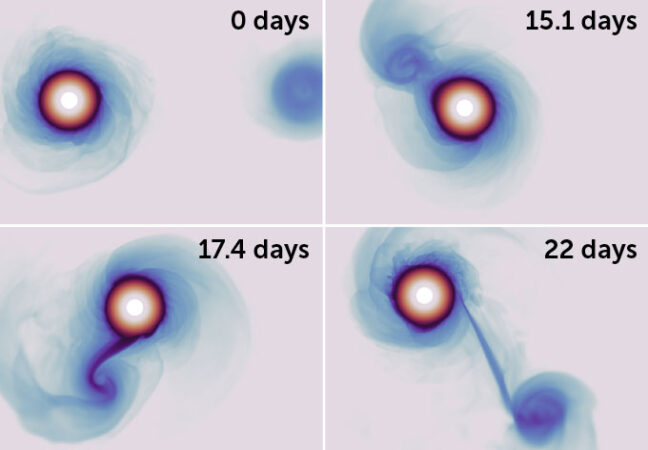This extreme star might have huge tidal waves
Gravitational forces between two orbiting stars might be creating huge waves of plasma on one of the stars that break and crash to the surface.

Like ocean surf smashing on a sandy beach, enormous waves of plasma may crash onto the surface of one massive star.
The star is part of a pair, stretched and pulled by its companion’s gravity. That gravitational tug-of-war causes the star’s brightness to change drastically and rhythmically. Now, a computer simulation suggests that this steady heartbeat of starlight is caused by giant tidal waves undulating and breaking on the star’s surface, researchers report August 10 in Nature Astronomy. The height of the waves could be up to three times the diameter of the sun.
“It’s quite rare to see these really kind of dramatic but transformative moments in action,” says astrophysicist Morgan MacLeod of the Harvard-Smithsonian Center for Astrophysics in Cambridge, Mass.
The star system, dubbed MACHO 80.7443.1718, sits about 160,000 light-years away from Earth in the Large Magellanic Cloud. It hosts one visible star that is 35 times the mass of the sun and another unseen star of at least 10 solar masses. About once a month, as they orbit each other, they pass near enough that gravitational forces raise tides on both stars’ surfaces, scientists suspect, much the way the moon tugs on Earth’s oceans (SN: 4/5/11).
On the stars, though, that tug would be substantially more extreme. “Instead of being a few meters tall, [the tide] can be 10 percent of the diameter of the star” that’s visible, says astrophysicist Jim Fuller of Caltech, who was not part of the study. On a star as big as that visible star — about 24 times as wide as the sun — that corresponds to a tidal wave roughly 3.3 million kilometers tall.
The new study, Fuller says, “shows how complicated and interesting the dynamics get when you have an extreme system like this.”
Astronomers can’t see the shapes of these stars through a telescope. but they can track how the brighter star’s light changes over time. While the brightness of most known “heartbeat stars” changes by about a tenth of a percent, the brightness of this system changes by 20 percent.
MacLeod wanted to know how the dynamics of this star system lead to those visible changes. So he and Harvard astronomer Avi Loeb simulated how plasma moves on and between these stars as they orbit one another.
The waves can get big enough that they actually break and crash across the brighter star’s surface, the study suggests. When an ocean wave is far from shore, it’s a rolling, undulating wave. But as it comes closer to shore, it rises and collapses on itself. “Something kind of parallel is happening here,” MacLeod says. The top of the wave steepens, “gets out of phase with the bottom, and it folds over on itself, and it crashes.”
After it crashes on the stellar surface, he says, “debris that’s thrown off is fed into this atmosphere around the star,” like the foamy surf left behind on a beach. As the waves crash, energy is lost. That crashing, the study suggests, causes the stars’ orbits to shrink, meaning eventually these stars could collide and possibly merge.
What's Your Reaction?




























































